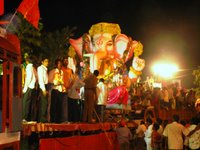 in all possible sizes sometimes even up to twenty feet.
in all possible sizes sometimes even up to twenty feet.People buy them and install them in their houses and worship the idol for one to ten days, after which the idol are taken out ceremoniously, carried in a procession through the streets of the town and immersed into the river, sea or well. The sea front at Mumbai, packed with people, is a spectacular sight.
On the day of the Chaturthi, the last of the days dedicated to the elephant-headed god, thousands of processions converge on the beaches of Mumbai to immerse the holy idols in the sea. This immersion is accompanied by drumbeats, devotional songs and dancing. Every year, the largest Ganesh idol is installed at Khairatabad in Hyderabad, which is more than 30 ft tall.
Each of these idols can be upto 10 metres in height and are paraded on lorries
 decorated with multi-coloured lights. At the other end of the scale, little Ganeshas are placed in nukkads or street corners and in homes, and pujas are performed daily. On the occasion of the Ganpati festival a large number of images are made of all possible sizes, and people buy them to keep in their houses as a divine guest for one and a half, five, seven, or ten days, after which the image is taken out ceremoniously and thrown into the river, sea or well for immersion or "visarjan". When he is immersed in the water, people sing,"'GANPATI BAPPA MORYA, AGLE BARAS TO JALDI AA," ("father Ganpati, next year come again.")
decorated with multi-coloured lights. At the other end of the scale, little Ganeshas are placed in nukkads or street corners and in homes, and pujas are performed daily. On the occasion of the Ganpati festival a large number of images are made of all possible sizes, and people buy them to keep in their houses as a divine guest for one and a half, five, seven, or ten days, after which the image is taken out ceremoniously and thrown into the river, sea or well for immersion or "visarjan". When he is immersed in the water, people sing,"'GANPATI BAPPA MORYA, AGLE BARAS TO JALDI AA," ("father Ganpati, next year come again.") Celebrating Ganesh's b-day was a wild experience. A normally conservative culture let loose. In spite of the thousands of people condensed into a very small area, I felt totally safe. At one point we found ourselves in the middle of a circle of hundreds of people dancing to the beat of drums and feeding off the energy from the roar of a crowd touched that we embraced their culture.



